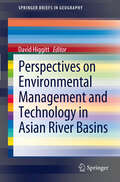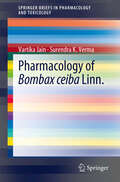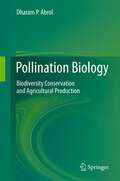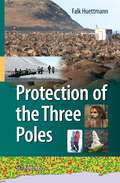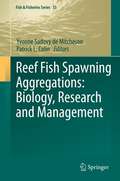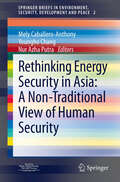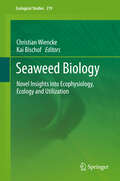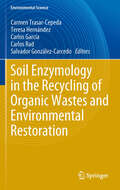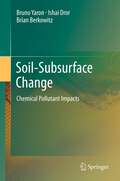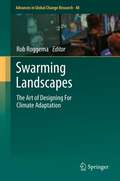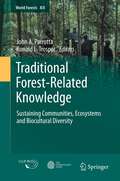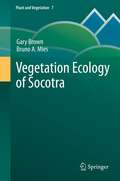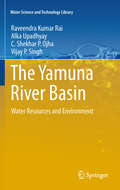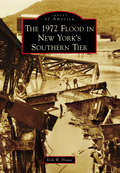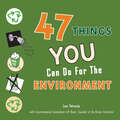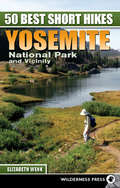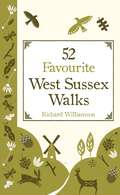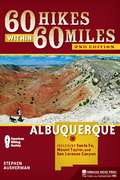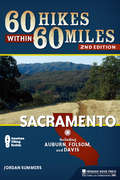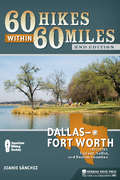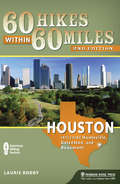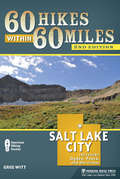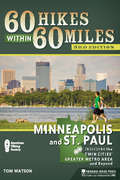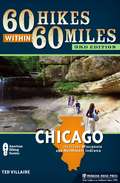- Table View
- List View
Perspectives on Environmental Management and Technology in Asian River Basins
by David HiggittAsian river basins are undergoing rapid transformation. This volume considers the implications of the environmental change-development nexus for water management, river health and hazard awareness. As Biswas and Tortajada (2011) have recently commented, water management in Asia will likely change more in the next twenty years than in the last 2000 years. Critical environmental trends include decreasing flows of water and sediment due to dam construction and increased water extraction, land use change (especially forest removal), encroachment and degradation of floodplain and wetland environments, increased water demand and concerns about water security, urban expansion and associated pollution of rivers and contamination of groundwater reserves. These challenges are being reframed by new approaches to water management which represent a transition from engineering-dominated approaches towards integrated water management, from technology transfer to adaptive technologies. The volume comprises an introduction and five chapters. Brierley and Callum reframe approaches to river repair within emerging theories of in ecology and earth science which regard nature as a complex adaptive system replete with inherent uncertainties. These ideas are mirrored in the four case study chapters which deal with water governance in the Mekong Basin (Hirsch); hybrid adoption of water resource technologies in India (Barbanente et al.); determination of sediment dynamics in Java Rijsdijk); and ecological conservation imperatives in the headwaters of the Yellow, Yangtze and Mekong rivers in western China (Li et al.).
Pharmacology of Bombax ceiba Linn.
by Vartika Jain Surendra K. VermaThis work is the first monograph devoted solely to Bombax ceiba, popularly known as the Red Silk Cotton Tree. Consisting of seven chapters, it covers all relevant aspects of this plant, from its historical and spiritual importance, to its botanical characterization, pharmacognostical details and ethnobiological uses, to its scientific validation in various animal and human studies. Each part of the tree is of medicinal value and possesses many novel chemical constituents such as shamimicin, bombasin, bombamalone, bombamaloside etc. along with other bioactive secondary metabolites. The book presents the chemical structures of the most important constituents and highlights various pharmacological activities, predominantly antioxidant, anti-inflammatory, anti-mutagenic, hypoglycemic, hypotensive, hepatoprotective and fibrinolytic, which may prove to be a source for the development of a novel phyto-pharmaceutical agent to treat diabetes, heart disease and cancer. In addition, separate chapters deal with the commercial and ecological significance of B. ceiba, as well as a case study on its conservation. Numerous color illustrations are included to identify the plant and to justify its nickname, the "Little Bird's Cafeteria".
Pollination Biology
by Dharam P. AbrolThis book has a wider approach not strictly focused on crop production compared to other books that are strictly oriented towards bees, but has a generalist approach to pollination biology. It also highlights relationships between introduced and wild pollinators and consequences of such introductions on communities of wild pollinating insects. The chapters on biochemical basis of plant-pollination interaction, pollination energetics, climate change and pollinators and pollinators as bioindicators of ecosystem functioning provide a base for future insights into pollination biology. The role of honeybees and wild bees on crop pollination, value of bee pollination, planned honeybee pollination, non-bee pollinators, safety of pollinators, pollination in cages, pollination for hybrid seed production, the problem of diseases, genetically modified plants and bees, the role of bees in improving food security and livelihoods, capacity building and awareness for pollinators are also discussed.
Protection of the Three Poles
by Falk HuettmannThe Arctic, the Antarctic, and the Hindu Kush-Himalayas form a trio of terrains sometimes called "the three poles". Mainly composed of rock, snow, and ice, these precious regions, which are home to many unique species such as the polar bear, the emperor penguin, and the snow leopard, contain the primary water resource of this planet and directly shape our climate. This book presents a first-ever global assessment and progressive review of the three poles and demonstrates the urgent need for their protection. Sins of the past have irrevocably harmed and threatened many of the unique qualities of these regions, and the future looks bleak with the global population forecast to reach 9 billion by 2060, and with climate change on the rise. Presented here is a wide-reaching and coherent overview of the three poles' biodiversity, habitats, and ongoing destruction. Failed protection and social targets set by the United Nations and other bodies are exposed while economic growth, unconstrained or inappropriate development, and urban sprawl are promoted unabated. Polar regions play a major role in the global agenda as they are rich in oil and other resources, marking them for contamination, overfishing, and further degradation. Tourism in the Antarctic has benefited from enlightened self-regulation, but there are signs that this is changing, too. The chapters of this book are written by experts in their fields, and their evidence leaves no doubt that we already live beyond our carrying capacity on a finite but decaying space. A global protection role model and several outlook scenarios are proposed to help set in motion polar protection priorities that are actually valid. Humanity has demonstrated through international treaties such as the Antarctic Treaty and the Madrid Protocol that we can put the interests of the planet as a whole first. This must become the norm, not the exception.
Reef Fish Spawning Aggregations: Biology, Research and Management
by Patrick L. Colin Yvonne Sadovy de MitchesonReef fish spawning aggregations, ranging from small groups to many tens of thousands of individuals, are spectacular but poorly known natural phenomena whereby fish assemble at specific times and locations to spawn. For some species these large groups may be the only form of reproduction, the high fish numbers briefly giving a false impression of stability and abundance--an 'illusion of plenty'. They are often a focus for intensive seasonal fishing because of their predictability and because many important commercial fishes form them. Highly vulnerable to overexploitation, many aggregations and their associated fisheries, have disappeared or are in decline. Few are effectively managed or incorporated into protected areas. Aggregations are not well understood by fishery scientists, managers and conservationists and their significance little appreciated by fishers or the wider public. To ensure their persistence to replenish important fisheries in coral ecosystems, maintain their ecosystem function and continue to delight divers, a significant change in perspective is needed to foster protection and management. This book provides comprehensive and practical coverage of the biology, study and management of reef fish aggregations, exploring their how, when, where, and why. It explores ways to better protect, study, manage and conserve them, while identifying key data gaps and questions. The text is extensively illustrated with many unique, never before published, photographs and graphics. Case studies on over 20 interesting and important fishes are included, outlining their biology and fisheries and highlighting major concerns and challenges.
Rethinking Energy Security in Asia: A Non-Traditional View of Human Security
by Mely Caballero-Anthony Youngho Chang Nur Azha PutraTraditional notions of security are premised on the primacy of state security. In relation to energy security, traditional policy thinking has focused on ensuring supply without much emphasis on socioeconomic and environmental impacts. Non-traditional security (NTS) scholars argue that threats to human security have become increasingly prominent since the end of the Cold War, and that it is thus critical to adopt a holistic and multidisciplinary approach in addressing rising energy needs. This volume represents the perspectives of scholars from across Asia, looking at diverse aspects of energy security through a non-traditional security lens. The issues covered include environmental and socioeconomic impacts, the role of the market, the role of civil society, energy sustainability and policy trends in the ASEAN region.
Seaweed Biology
by Christian Wiencke Kai BischofSeaweeds, also known as macroalgae, are among the most important primary producers and act as ecological engineers on rocky coasts of the world's oceans. In addition to their extreme ecological importance they are also of high economic relevance. Complementing available textbooks with its more research-oriented approach, this volume contains 22 chapters by renowned experts, grouped in five parts. In Part I fundamental processes and acclimation strategies of seaweeds towards the abiotic environment are covered. Part II focuses on the multitude of biotic interactions in seaweed communities, and in Part III the reader is introduced to the structure and function of the main seaweed systems of the world. The chapters of Part IV highlight and discuss the effects of global and local environmental changes on seaweeds and their communities. In the final Part V a comprehensive overview of developments in seaweed aquaculture, industrial applications and the overall economic importance of seaweeds is provided. Summarizing the advances in seaweed biology achieved within the last few decades, this book also identifies gaps in the present knowledge and needs for future research.
Soil Enzymology in the Recycling of Organic Wastes and Environmental Restoration
by Salvador González-Carcedo Carmen Trasar-Cepeda Teresa Hernández Carlos Rad Carlos GarcíaSoil enzymes play a fundamental role in many soil processes such as the mineralization of organic matter, the synthesis of humic substances, the degradation of xenobiotics or the mechanisms involved in the biocontrol of plant pathogens. Their direct link with soil microorganisms gives them a key role as biomonitors of the evolution of soil quality or in the monitoring of the application of organic amendments to degraded soils. As a consequence of the importance of soil enzymes on soil processes, there is an increasing interest in their study, as well as in the application of molecular techniques as diagnostic tools.
Soil-Subsurface Change
by Brian Berkowitz Bruno Yaron Ishai DrorThis book combines soil science, earth science, and environmental geochemistry, providing comprehensive background information for specialists interested in chemical-induced changes in the soil-subsurface system. Readers are introduced to the chemistry of contaminants that often disturb the natural soil-subsurface equilibrium as a result of human activity. While the soil-subsurface system has in many cases been affected by human impact, the effects of chemical contaminants on the actual matrix and properties have been largely neglected. The major focus of the book is on changes to the soil-subsurface matrix and properties caused by chemical pollution. By integrating results available in the literature, we observe that chemical pollutants may lead to the irreversible formation of a new soil-subsurface regime characterized by a matrix and properties different than those of the natural regime. In contrast to the geological time scales dictating natural changes to the matrix and properties of the soil-subsurface system, the time scale associated with chemical pollutant-induced changes is far shorter and extends over a "human lifetime scale." The numerous examples presented in the book confirm that chemical contamination should be considered as an additional factor in the formation of a contemporary soil-subsurface regime that is different than that of the pristine system.
Swarming Landscapes
by Rob RoggemaThis book advocates a fresh approach to planning that anticipates, rather than reacts to, the changes in climate currently in process. Today's spatial planning procedures rely on historical evidence instead of preparing for factors that by definition lie in the future, yet which are relatively uncontroversial: shortages of water, sea level rise and rises in average temperatures being but three examples. Arguing for more flexibility, the contributors view 'complexity' as the key to transforming the way we plan in order to better equip us to face uncertainties about our future environment.
Traditional Forest-Related Knowledge
by John A. Parrotta Ronald L. TrosperExploring a topic of vital and ongoing importance, Traditional Forest Knowledge examines the history, current status and trends in the development and application of traditional forest knowledge by local and indigenous communities worldwide. It considers the interplay between traditional beliefs and practices and formal forest science and interrogates the often uneasy relationship between these different knowledge systems. The contents also highlight efforts to conserve and promote traditional forest management practices that balance the environmental, economic and social objectives of forest management. It places these efforts in the context of recent trends towards the devolution of forest management authority in many parts of the world. The book includes regional chapters covering North America, South America, Africa, Europe, Asia and the Australia-Pacific region. As well as relating the general factors mentioned above to these specific areas, these chapters cover issues of special regional significance, such as the importance of traditional knowledge and practices for food security, economic development and cultural identity. Other chapters examine topics ranging from key policy issues to the significant programs of regional and international organisations, and from research ethics and best practices for scientific study of traditional knowledge to the adaptation of traditional forest knowledge to climate change and globalisation.
Vegetation Ecology of Socotra
by Bruno Mies Gary BrownAlthough the unique flora of the Socotra Archipelago with its high degree of endemism has received much attention recently, little information is available on the vegetation and related ecological aspects. Based on their extensive field experience of the region, the authors have assimilated a vast amount of knowledge to produce this book, which gives a detailed insight into the plant ecology of Socotra, designated as a World Heritage Site by UNESCO in 2008. The book is divided into seven chapters. After a brief introduction and overviews of important abiotic features, various aspects of the vascular flora are presented in Chapter 4, together with accounts of the bryophyte and lichen flora. Ecology and adaptive strategies of the plants are dealt with in Chapter 5, and Chapter 6 gives a concise description of the main vegetation units. Finally, important management issues of the vegetation are discussed, an essential topic to ensure preservation of the natural heritage of the archipelago.
The Yamuna River Basin
by Alka Upadhyay C. Shekhar Ojha Raveendra Kumar Rai Vijay P. SinghThis book is designed to provide concepts, methodologies, and approaches for river basin studies with respect to water resources and environment. The book is not limited to the Yamuna River basin, but will help in the study of various other river basins for integrated water resources management. The book covers the essential components of integrated water resources management, including analysis of climatic variables, climate change detection, analysis of natural resources, geology, geomorphology, socio-economics, water budgeting, flood estimation, river pollution, etc. Furthermore, the book addresses recent issues pertaining to water quality, water quality indices, environmental flows, water resources management through cropping pattern change, etc. along with methodologies and application to the Yamuna River system. However, the main objective of this book is to address important issues of water resources management of river basins. Audience: The manuscript has been designed so that it can be used as a reference for river basin studies. The book will be useful to engineers, agricultural scientists, environmentalists, planners, managers, and administrators who are concerned with water resources.
1972 Flood in New York's Southern Tier, The (Images of America)
by Kirk W. HouseIn June 1972, Hurricane Agnes hit the East Coast with a monstrous and devastating force, bringing a deluge across multiple states and slamming four counties in the Southern Tier: Steuben, Chemung, Tioga, and Broome. Dozens died and property damage ran into the millions as Corning, Elmira, Owego, Binghamton, and other communities suddenly found themselves under water. The flood destroyed the Erie Lackawanna Railroad, staggered the Penn Central, shut down Corning Glass Works for weeks, and devastated the Corning Museum of Glass--a major cultural resource. Lives and landscapes were forever changed when homes and businesses washed away in a matter of minutes. Henceforth, the region's history became permanently divided into the times before and the times after the 1972 flood. Through stunning images, The 1972 Flood in New York's Southern Tier chronicles the extraordinary destruction of twisted rail lines, devastated streets, exhausted recovery workers, rivers bursting their banks, cars on houses, and houses on cars, all while capturing the communities' rebuilding efforts and recovery of the glass museum treasures.
47 Things You Can Do for the Environment
by Lexi Petronis Jill BuckSure, we all know the planet is in trouble. We hear talk all the time about climate change, air pollution from cars, oil spills into oceans, trash overflowing into waterways, and toxic chemicals leaking into our groundwater. Sigh. But the good news is there’s a lot we can do to start cleaning up the Earth. And it starts with you!
50 Best Short Hikes: Yosemite National Park and Vicinity
by Elizabeth Wenk50 Best Short Hikes: Yosemite National Park and Vicinity leads hikers of all skill levels to some of the most stunning landscapes Yosemite has to offer including: bubbling alpine creeks, smooth glaciated slabs, giant sequoias, deep dark blue lakes, and rock as far as the eye can see. In addition to in-depth hike descriptions, the author has also included information about the parks natural history, complex landscape, and its human history. Additional information includes tips on keeping yourself and your family safe, the park's natural predators, and helpful weather information.
52 Favourite West Sussex Walks
by Richard WilliamsonRichard Williamson’s weekly walking column is one of the most popular features in the Chichester Observer, Worthing Observer and West Sussex Gazette. Now he has compiled his favourite walks – one for every week of the year. With hand-drawn route maps and practical notes, these routes can be covered easily in an afternoon.
52 Favourite West Sussex Walks
by Richard WilliamsonRichard Williamson’s weekly walking column is one of the most popular features in the Chichester Observer, Worthing Observer and West Sussex Gazette. Now he has compiled his favourite walks – one for every week of the year. With hand-drawn route maps and practical notes, these routes can be covered easily in an afternoon.
60 Hikes Within 60 Miles: Albuquerque
by Stephen AushermanThis newly updated and revised edition of 60 Hikes within 60 Miles: Albuquerque hits classic trails and uncovers paths where no guidebook has gone before. This is the essential guide to north-central New Mexico, from the black lava badlands in El Malpais National Monument to the cool aspens in Santa Fe National Forest. Explore newly opened lands in the Ojito Wilderness and the Valles Caldera, or revisit the past with nostalgic walks along the Rio Grande and Route 66. Hikes lead to ancient pueblos, ghost towns, slot canyons, strange hoodoos and other treasures in the heart of New Mexico, all just a daytrip or less from the Duke City.Each chapter serves as both a navigational aide and an interpretive guide to familiarize hikers with wondrous destinations in the Land of Enchantment. From the black lava badlands in El Malpais National Monument to the aspen trees in Santa Fe National Forest, the Albuquerque area is filled with beautiful wilderness perfect for exploration. This comprehensive guidebook outlines the level of difficulty for each hike, and includes extensive maps and trail profiles to assist hiking enthusiasts and day-trippers alike. Experience the Rio Grande, old Route 66, ancient pueblos, ghost towns, and other charms of the area with this essential guide.
60 Hikes Within 60 Miles: Sacramento
by Jordan SummersCarefully researched on foot, hiking enthusiast Jordan Summers introduces area residents and visitors to an array of the best day hikes from casual riverside nature hikes to rugged foothill treks within roughly an hour's drive of Sacramento.Filled with detailed descriptions of firsthand trail notes, this newly updated edition of 60 Hikes Within 60 Miles: Sacramento helps hikers discover their choices with concise at-a-glance information highlighting details such as location, access, directions, distances, scenery, and preparation details that help hikers get the most from each outing. Precise maps, descriptive text, photos, and trailhead coordinates guide you on your way quickly and keep you on route reliably. Discover the varied geology, the cultural history, and the natural beauty of the foothills, mother lode, and delta regions in 60 Hikes Within 60 Miles: Sacramento.
60 Hikes Within 60 Miles: Dallas/Fort Worth
by Joanie Sanchez60 Hikes within 60 Miles: Dallas / Fort Worth covers the best trails the metroplex has to offer, including popular trails as well as lesser-known paths no guidebook has covered before. This is the essential guide you'll need for hiking in the Dallas / Fort Worth Metroplex. Choose a trek alongside ancient dinosaur tracks at Dinosaur Valley State Park, or follow fresh prints of live coyote and white-tailed deer at Lake Mineral Wells. Explore remnants of Texas' disappearing blackland prairie, or wander amongst the dense hardwood forests of the riparian wetlands. A hike for every mood, you can pick a quiet hike to a secluded pecan grove or an upbeat populated hike to a State Champion Oak Tree - or maybe you just want to feel like a pioneer as you hike through the wilderness of the LBJ National Grasslands. Hikes include treks through open prairies, rolling hillsides, lakeside beaches, and other treasures all found just a daytrip or less from the Dallas / Fort Worth Metroplex.
60 Hikes Within 60 Miles: Houston
by Laurie Roddy60 Hikes within 60 Miles: Houston uncovers hikes around Houston that previously had gone unnoticed. This is the essential guide to this area, from the Big Thicket of east Texas to the coast of Galveston Island. Explore most of the 138-mile Lone Star Trail with over a dozen hikes breaking up the trail into manageable segments. Hikes lead to old native homesteads, native prairies, deep forests, riparian woodlands, urban byways, wildlife preserves along the Great Texas Coastal Birding Trail, wetlands, and numerous bayous and waterways. Each chapter serves as both a navigational aide and an interpretive guide to familiarize hikers with wondrous destinations in and around The Bayou City.
60 Hikes Within 60 Miles: Salt Lake City
by Greg Witt60 Hikes Within 60 Miles: Salt Lake City is the only guidebook that pinpoints the most exceptional hikes in the area. It contains meticulous trail descriptions that range from comfortable strolls for families to difficult treks for those looking for a challenging workout. Extensive key-at-a-glance information makes it easier to choose a hike based on length, difficulty, or scenery. A helpful list of hikes in the front of the book highlights those with special interests - best hikes for children, scenic hikes, hikes good for wildlife viewing, best hikes for runners, and more. Each hike report includes commentary on trailside geology, flowers, and wildlife. Historical notes provide fascinating details about early miners, trailblazers, the Pony Express, and Mormon pioneers.Nestled in the western flank of the Rockies, Salt Lake City provides ready access to a stunning array of hiking options amid alpine lakes, snow-draped mountain peaks, fragrant evergreen forests, deep canyon waterfalls, granite towers, and flowered cirques. Within 60 miles of Salt Lake City there are thousands of square miles of national forest, National Wilderness Areas, state parks and designated recreation areas to explore.Now, with this updated edition of 60 Hikes within 60 Miles: Salt Lake City, whether lacing up boots, stepping into sneakers or strapping on snowshoes, Salt Lake City is even more accessible for hikers.
60 Hikes Within 60 Miles: Minneapolis and St. Paul
by Tom WatsonWithin the seven county "metro" area that encompasses the Twin Cities of Minneapolis and St. Paul lies a network of hundreds of miles of trails. Hikes were selected to be representative of the area, showcasing the park or region's main attractions or personality. Some of these trails are broad, paved corridors through multi-use parks generously developed to provide a myriad of recreational opportunities for the young and old, the robust trekker, and the casual stroller.Trails are based in a wide range of areas such as walkways of grass winding through majestic stands of Minnesota hardwoods. Other hikes are spider-web networks that remind one of well-used deer trails. Some are isolated within a pocket of greenery surrounded by vast ribbons of freeway concrete and broad subdivisions. Others are woven within the fabric of parklands so expansive that you could literally spend weeks hiking all the networks lying within their folds. Twin Cities' hiking is huge so get the guide that gets you there and back.This decisive guide to day hikes in the Twin Cities' area just got better. Updated maps, new hikes, new photos, and brand-new trailhead coordinates make Tom Watson's authoritative guide even more useful than before.
60 Hikes Within 60 Miles: Chicago
by Ted VillaireIn addition to Chicago's numerous cultural and athletic activities, there are many excellent opportunities to explore Mother Nature's bounty. From the dunes of Lake Michigan to the hills and lakes of the northwest to the prairies of the south, hikers will find a trail to their liking in this updated edition of 60 Hikes within 60 Miles: Chicago.Hikes were chosen for their scenic appeal, but they were also chosen for their historic attractions. The extensive key-at-a-glance information makes it a snap to choose a hike based on length, difficulty, and scenery. Helpful lists highlight the best hikes for children, for wildlife viewing, and other categories.Whether a long-time Chicago resident or vacationer to the area, this updated guide will make choosing the right hike easy and enjoyable.
